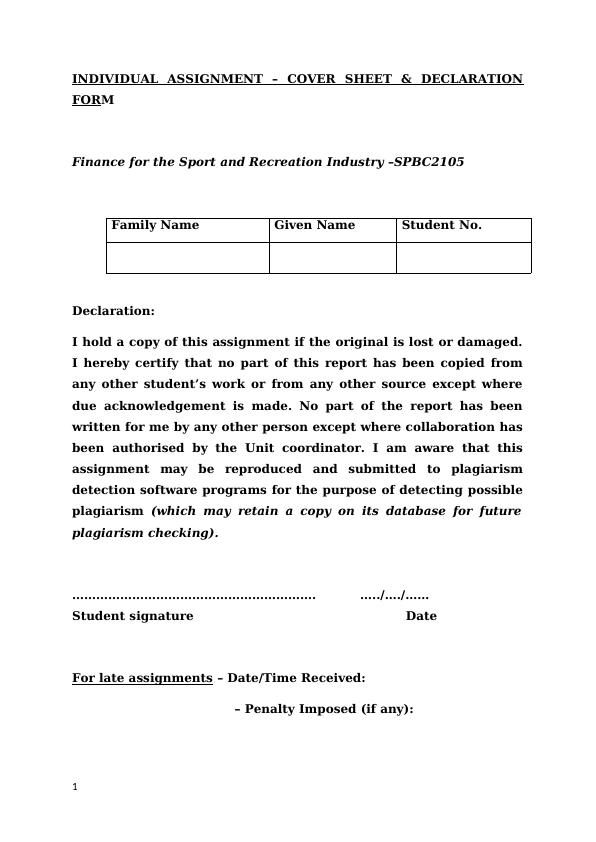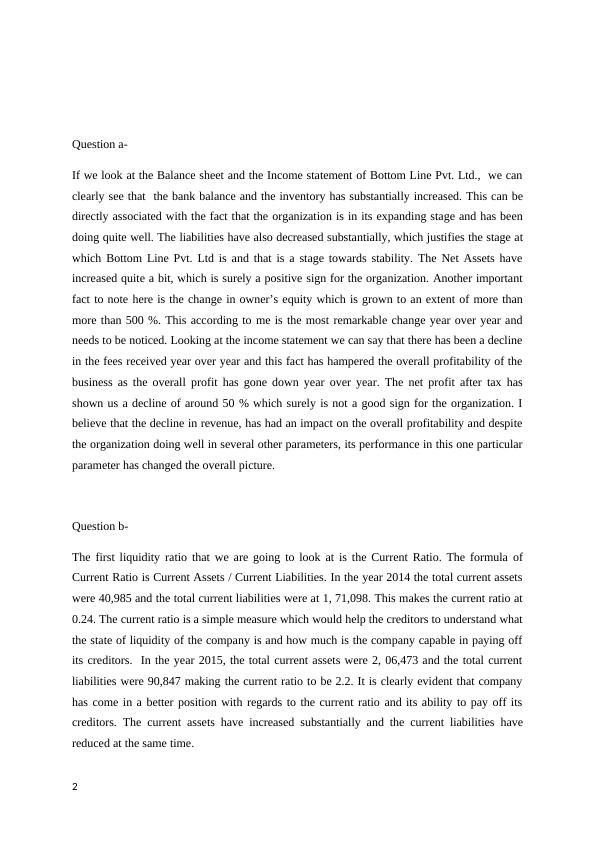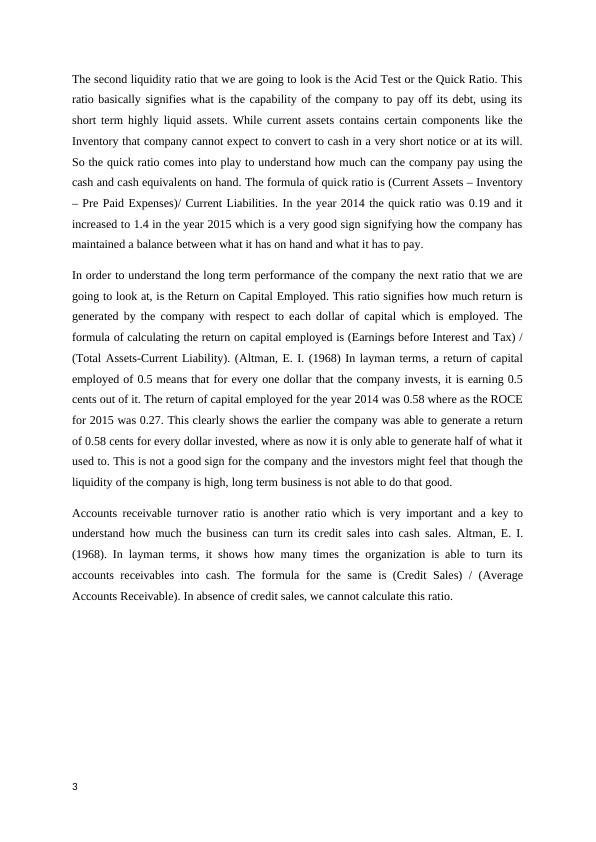Ask a question from expert
Finance For The Sport And Recreation Industry –SPBC2105
10 Pages2032 Words156 Views
Added on 2019-09-26
Finance For The Sport And Recreation Industry –SPBC2105
Added on 2019-09-26
BookmarkShareRelated Documents
INDIVIDUAL ASSIGNMENT – COVER SHEET & DECLARATIONFORMFinance for the Sport and Recreation Industry –SPBC2105Family NameGiven NameStudent No.Declaration: I hold a copy of this assignment if the original is lost or damaged.I hereby certify that no part of this report has been copied fromany other student’s work or from any other source except wheredue acknowledgement is made. No part of the report has beenwritten for me by any other person except where collaboration hasbeen authorised by the Unit coordinator. I am aware that thisassignment may be reproduced and submitted to plagiarismdetection software programs for the purpose of detecting possibleplagiarism (which may retain a copy on its database for futureplagiarism checking). ................................................................../..../......Student signature DateFor late assignments – Date/Time Received: – Penalty Imposed (if any):1

Question a-If we look at the Balance sheet and the Income statement of Bottom Line Pvt. Ltd., we canclearly see that the bank balance and the inventory has substantially increased. This can bedirectly associated with the fact that the organization is in its expanding stage and has beendoing quite well. The liabilities have also decreased substantially, which justifies the stage atwhich Bottom Line Pvt. Ltd is and that is a stage towards stability. The Net Assets haveincreased quite a bit, which is surely a positive sign for the organization. Another importantfact to note here is the change in owner’s equity which is grown to an extent of more thanmore than 500 %. This according to me is the most remarkable change year over year andneeds to be noticed. Looking at the income statement we can say that there has been a declinein the fees received year over year and this fact has hampered the overall profitability of thebusiness as the overall profit has gone down year over year. The net profit after tax hasshown us a decline of around 50 % which surely is not a good sign for the organization. Ibelieve that the decline in revenue, has had an impact on the overall profitability and despitethe organization doing well in several other parameters, its performance in this one particularparameter has changed the overall picture. Question b-The first liquidity ratio that we are going to look at is the Current Ratio. The formula ofCurrent Ratio is Current Assets / Current Liabilities. In the year 2014 the total current assetswere 40,985 and the total current liabilities were at 1, 71,098. This makes the current ratio at0.24. The current ratio is a simple measure which would help the creditors to understand whatthe state of liquidity of the company is and how much is the company capable in paying offits creditors. In the year 2015, the total current assets were 2, 06,473 and the total currentliabilities were 90,847 making the current ratio to be 2.2. It is clearly evident that companyhas come in a better position with regards to the current ratio and its ability to pay off itscreditors. The current assets have increased substantially and the current liabilities havereduced at the same time. 2

The second liquidity ratio that we are going to look is the Acid Test or the Quick Ratio. Thisratio basically signifies what is the capability of the company to pay off its debt, using itsshort term highly liquid assets. While current assets contains certain components like theInventory that company cannot expect to convert to cash in a very short notice or at its will.So the quick ratio comes into play to understand how much can the company pay using thecash and cash equivalents on hand. The formula of quick ratio is (Current Assets – Inventory– Pre Paid Expenses)/ Current Liabilities. In the year 2014 the quick ratio was 0.19 and itincreased to 1.4 in the year 2015 which is a very good sign signifying how the company hasmaintained a balance between what it has on hand and what it has to pay. In order to understand the long term performance of the company the next ratio that we aregoing to look at, is the Return on Capital Employed. This ratio signifies how much return isgenerated by the company with respect to each dollar of capital which is employed. Theformula of calculating the return on capital employed is (Earnings before Interest and Tax) /(Total Assets-Current Liability). (Altman, E. I. (1968) In layman terms, a return of capitalemployed of 0.5 means that for every one dollar that the company invests, it is earning 0.5cents out of it. The return of capital employed for the year 2014 was 0.58 where as the ROCEfor 2015 was 0.27. This clearly shows the earlier the company was able to generate a returnof 0.58 cents for every dollar invested, where as now it is only able to generate half of what itused to. This is not a good sign for the company and the investors might feel that though theliquidity of the company is high, long term business is not able to do that good.Accounts receivable turnover ratio is another ratio which is very important and a key tounderstand how much the business can turn its credit sales into cash sales. Altman, E. I.(1968). In layman terms, it shows how many times the organization is able to turn itsaccounts receivables into cash. The formula for the same is (Credit Sales) / (AverageAccounts Receivable). In absence of credit sales, we cannot calculate this ratio. 3

End of preview
Want to access all the pages? Upload your documents or become a member.
Related Documents
Financial Analysis of Cisco: Profitability, Liquidity, Solvency and Market-Based Ratioslg...
|9
|1796
|295
Audit Program for Australia Bank Limited Companylg...
|16
|1631
|139
Assignment On Accounting for Managerslg...
|9
|3280
|38
Finance Business Planlg...
|7
|931
|156
Assignment on Telecommunicationlg...
|30
|2084
|109
Ratio Analysis and Evaluation of Corporate Reporting in Wesfarmerslg...
|13
|2829
|93